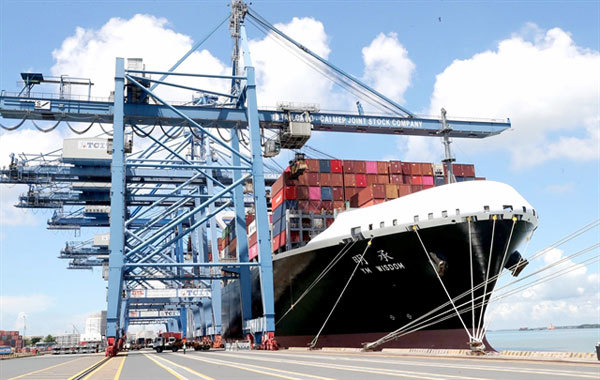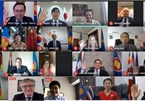born 10 years ago in 2010, also a year Vietnam held the Chairmanship of the regional bloc.
 |
| Loading and unloading of commodities containers at Tan Cang - Cai Mep port in Vietnam's south-central province of Ba Ria-Vung Tau. — VNA/VNS Photo Trong Duc |
"In October 2010, ASEAN leaders issued the Hanoi Declaration which adopted the Master Plan on ASEAN Connectivity (MPAC) 2010-2020 during the 17th ASEAN Summit held in Vietnam. However, in 2015, to synchronise the plan with the ASEAN Community Vision 2025 and the 2015 plan to build a community across the three political-security, economic, and socio-cultural pillars, the member countries decided to halt the master plan when it had reached only half of its intended length and build a new master plan for the duration 2016-2025, or MPAC 2025, which was later adopted at the 28th ASEAN Summit held in Laos in September 2016.
In phase 1 from 2010-2015, MPAC set a large number of priorities and initiatives, leading to an overspreading of resources during the implementation. After five years, 39 out of 125 initiatives of 19 core strategies have been accomplished by ASEAN countries.
In the second phase from 2016 to 2025 (MPAC 2025), the majority of the unfinished Phase 1 initiatives have shifted to other ASEAN pillars, mainly Economy and Socio-Culture. The MPAC 2025 focuses on the number of more relevant focus, with 15 initiatives in five strategic areas: (i) sustainable infrastructure, (ii) digital innovation, (iii) inter-connected logistics, (iv) optimisation of planning and (v) human mobility.
During Vietnam’s ASEAN Chairmanship 2020, despite huge challenges posed by the COVID-19 pandemic, MPAC 2025 still reaped considerable achievements.
In terms of sustainable infrastructure, projects in ASEAN’s potential list continued to be promoted via capacity building and technical assistance programmes. The infrastructure efficiency enhancement framework was approved in June 2020 with a regional capacity building programme for the 2021-23 period. The building of a network of cities in the ASEAN Sustainable Urbanisation Strategy (ASUS) has seen positive progress. The first phase of the project 'Development of an ASEAN Database on Trade Routes and Framework for Enhancing Supply Chain Efficiency' as part of the inter-connected logistics network strategy was completed in July and the entire database is expected to be finished by the end of 2020.
The project to 'Enhance ASEAN Tourism Digital Platforms] as part of the human mobility strategy was moved to later this year.
MPAC, MPAC 2025 and ASEAN Connectivity have always been considered high priorities by Vietnam, demonstrated in the second point of our five priorities in the Chairmanship Year 2020. For Vietnam, the activity that is most effective is the group of initiatives in the field of sustainable infrastructure as put forward by the Ministry of Planning and Investment.
In other sectors, Vietnam’s participation is highly dependent on the level of interest of the specialised agencies in charge of the respective sector. Although projects under the MPAC 2025 framework still bring significant benefits to Vietnam and ASEAN, the scale of activities and awareness of our ministries on MPAC 2025 in recent years seemed to be on a downward trend, as the focal officers of the ministries are not assigned to work full-time on the initiatives but often concurrently hold many other duties.
This year, as Chair of the ASEAN Connectivity Coordinating Committee (ACCC), Vietnam has carried out the Midterm Review (MTR) to evaluate the implementation of MPAC 2025 to submit to the 37th ASEAN Summit to be approved in November 2020, and with it, launched the ASEAN Community building master plan to 2025 on the three pillars.
In short, Vietnam has left two bold imprints in the history and implementation of MPAC, in 2010 with the introduction of the first phase MPAC in Hanoi, and in 2020 with the mid-term review of the MPAC 2025.
Based on the recommendations from the mid-term review of MPAC 2025 to more effectively implement the projects and initiatives in the second half of the MPAC 2025, we need to strengthen co-ordination between Vietnam’s specialised agencies with each other and with their counterparts in other ASEAN countries and elevate domestic awareness of ASEAN Connectivity as well as MPAC 2025.
A stricter monitoring mechanism to ensure projects are implemented on schedule and avoid affecting the overall implementation in ASEAN countries should be in place, while the bloc continues to call on ASEAN partners to finance more projects within the framework of MPAC 2025.
Since the beginning of 2020, the region and the world at large have been facing many uncertain factors such as the COVID-19 pandemic, the US-China trade war, and the rise in protectionism across the globe. ASEAN and its partners agree that the initiatives under MPAC 2025 have positive socio-economic effects and demonstrate the bloc’s resilience to emerging regional trends, particularly relevant and reciprocal with the ASEAN Recovery Framework post-COVID-19.
ASEAN connectivity has become an essential issue in the region’s recovery plan during and after the COVID-19 pandemic, and it should be helpful in strengthening ASEAN countries’ capacities to respond to future pandemics. Specifically, the MPAC 2025 initiatives can support the recovery of economic growth and employment with initiatives and projects on investments in sustainable infrastructure, tourism promotions, and training programmes to support unemployed workers.
Connectivity should also help consolidate the regional bloc’s capacity to manage future health crises, while helping individuals and businesses be in a stronger position to respond to the economic impacts of epidemics, including COVID-19, from initiatives and projects on sustainable urbanisation, open databases, digitising the operations of small- and medium-sized enterprises, and expanding financial services.
In the context of volatile regional and global situation rifled with complex and multidimensional issues, ASEAN connectivity and MPAC have an increasingly important role and are always included on the agenda of ASEAN countries and its partners, especially as ASEAN pays more focus on dealing with interdisciplinary and inter-pillar issues.
The MPAC 2025 mid-term report not only plays an important role in helping ASEAN implement the next half of the MPAC more effectively, but it also makes a practical contribution to the development of the ASEAN Community Vision after 2025.
In this respect, it can be said that ASEAN connectivity is becoming the fourth Pillar of ASEAN, helping to link the three traditional pillars of politics-security, economy, and socio-culture." VNS

ASEAN Connectivity Coordinating Committee holds consultation with partners
The ASEAN Connectivity Coordinating Committee held an online consultation with dialogue partners and other partners on August 26 under the chair of Ambassador Tran Duc Binh, head of Vietnam’s delegation to ASEAN.